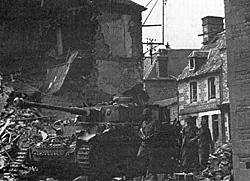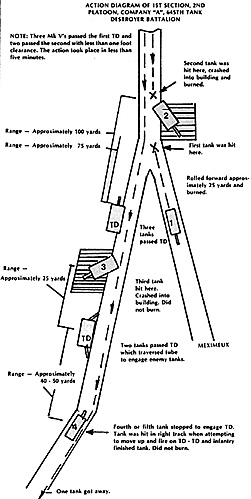 Consider the following scene - S/Sgt Mark Horrible
peers through the commander's/gunner's view port of his
M3 Stuart light tank located in the bois de Verde,
somewhere in France, 1944. His primary concern is the
bridge over the unfordable Dieppe river to his front. As the
lead tank of the lead platoon he knows that no friendlies
are to his front.
Consider the following scene - S/Sgt Mark Horrible
peers through the commander's/gunner's view port of his
M3 Stuart light tank located in the bois de Verde,
somewhere in France, 1944. His primary concern is the
bridge over the unfordable Dieppe river to his front. As the
lead tank of the lead platoon he knows that no friendlies
are to his front.
Suddenly, the sound of tank engines can be heard from the other side of the river. Through his 37mm gun sight S/Sgt Horrible watches a squat, black shape lumber towards the bridge. "Great Grey Ghosts of Gela!" exclaims Mark, "A German PzKpfw Mark Vl Tiger I tank!" Horrible watches in horror as the huge tank rumbles over the bridge firing at the other two M3's of Mark's platoon. S/Sgt Mark Horrible kicks his driver twice in the side of the head (A quaint signalling technique picked up from the British, of course they merely tapped the driver on the shoulder.) "Advance towards the bridge!" he yells.
The Stuart leaps forward and roars past the Tiger who is still concentrating on the two burning hulks, all that remain of the other two Stuarts. Mark reaches the bridge directly behind the Tiger and begins to pump shell after shell into the rear of the German tank. Lo and behold the Tiger begins to burn! Suddenly an irate voice cries out "FOUL! YOU CAN'T DO THAT. IT'S NOT REALISTIC!"
This event actually occured during a wargame fought using TSR's TRACTICS rules. While conducting research at the National Archives I ran across several interesting reports concerning "real" actions during World War II which might help provide some examples of realistic tank actions.
At the end of World War II the Ordinance Section of the First US Army Headquarters compiled an unpublished statistical study of First US Army tank losses. Data was presented on the M4 Sherman (all models were lumped together), the M5A1 and the M26. For the purpose of this article I will present only the data on the M4.
759 M4's were considered a total loss in the First US Army area from June 1944 to April 1945. 321 (40%) of these burned. The following breakdown is by the type weapon causing the loss:
ANTI-TANK (Includes tank guns and towed AT guns). Of a total lost of 234 (20% of the overall loss),113 (48% of these lost due to AT fire) were burned. Type weapons causing loss: 1-37mm; 1-47mm; 1-57mm; 92-75mm; 3-76mm; 109-88mm (53%); 27-unknown caliber.
| RANGES FROM M4 TO AT WEAPON | |||
|---|---|---|---|
| 1-10yds | 2-250 yds | 4-700 yds | 1-1700 yds |
| 1-15yds | 8-300 yds | 18-800 yds | 4-1800 yds |
| 2-50yds | 2-350 yds | 5-900 yds | 7-2000 yds |
| 1-75yds | 10-400 yds | 32-1000 yds | 6-3000 yds |
| 4-100 yds | 1-450 yds | 6-1200 yds | 2-4000 yds |
| 4-150 yds | 11-500 yds | 8-1500 yds | 1-4500 yds |
| 9-200 yds | 26-600 yds | 1-1600 yds | 57-? range |
(60% of the hits were made between 400 and 1000 yds)
MINES (no size specified): Of a total lost of 144 (18% of the overall loss). 8 (6% of those lost due to mines) were burned.
ARTILLERY (both direct and indirect fire): Of a total lost of 220 (28% of the overall loss), 97 (44% of those lost to artillery fire) were burned. Type weapons causing loss: 105-75mm; 1-77mm; 13-105mm; 1-155mm; 2-170mm; 6-178mm; 92-unknown caliber.
| RANGES | |||
|---|---|---|---|
| 9-100 yds | 1-350 yds | 1-750 yds | 1-3000 yds |
| 4-150 yds | 4-400 yds | 3-800 yds | 1-3500 yds |
| 6-200 yds | 1-500 yds | 6-1000 yds | 2-8000 yds |
| 3-250 yds | 52-600 yds | 1-1200 yds | 11-? range |
| 4-300 yds | 2-700 yds | 3-1500 yds | . |
(66% of the hits were made between 400 and 1000 yds)
ANTI-TANK RIFLE GRENADES: Of the total lost of 24 (3% of the overall loss), 8 ( 38% of those lost due to ATRGs) were burned. Ranges were 1 at 35 yds, 22 at 100 yds, and 1 at 150 yds.
PANZERFAUST: Of the total lost of 77 (10% of the overall loss), 25 (32% of those lost due to Panzerfausts) were burned.
| RANGES | |||
|---|---|---|---|
| 5-10 yds | 5-40 yds | 6-70 yds | 1-300 yds |
| 11-20 yds | 5-50 yds | 6- 100 yds | 23-? range |
| 12-30 yds | 2-60 yds | 1- 150 yds | . |
(95% of the hits were made between 10 and 100 yds)
81 MM MORTER: Of the total lost of 6 (1% of the overall loss), 1 (17% of those lost to mortars) was burned. The ranges were 3 at 600 yds and 3 at unknown ranges.
SMALL ARMS FIRE One M4 was lost due to intensive close range small arms fire directed at the gun, gun mantle and gun sight. The gun was so severly damaged that the Ordinance personal certified the tank as a total loss!
A further 90 M4's were lost from unknown causes.
How do your rules stack up to this data? To further confuse the issue think about the following true story of how two M10 tank destroyers made out against five Mk V Panther tanks (Courtesy of Records Group no. 407, box 2000, The National Archives, Suitland, MD):
ACTION OF 1ST SECTION, 2ND PLATOON, COMPANY A, 645TH TANK DESTROYER BATTALION DURING AUGUST, 1944, NEAR MEXIMEUX, FRANCE.
"Two M10 tank destroyers were moved into the town of Meximeux, on the reported threat of an enemy tank attack. The two tank destroyers were positioned near the center of town, with approximately 100 yards interval. Both tank destroyers were partially protected by near buildings on the left hand side of the street; however, two-thirds of the vehicles remained in the street (See attached sketch). At 1340B, approximately 10 minutes after the tank destroyers had taken up this position, the tank attack started. The main street of the town was very wide, and two Mark V tanks were observed moving up abreast at full speed, firing their machine guns and crushing anything that might be in their way.
One Mark V moved ahead of the other and had almost reached the center of town, near the 'Y' intersection when the leading tank destroyer fired one round of APCBDF. This projectile, fired at 75 yards range, hit the tank just above the right track, penetrating the right hull near the front. This immediately set the tank on fire. The tank rolled for another 25 yards before it finally stopped. The gunner had the second tank in his sight and was ready to fire only a few seconds later. He fired at a range of 100 yards, hitting the tank a few yards short of the first tank, striking it almost identically in the same place. The one round of APCBDF set the tank ablaze. This tank rolled into a building, setting the building and adjoining houses on fire.
The other three tanks were described as nearly 'frying' when they passed the first tank destroyer. The leading tank of these three was almost on the second tank destroyer before the TD fired. The range was reported as being 25 yards or less. One round of HE was fired at this Mark V, which immediately headed into a nearby building. The crew attempted to evacuate the disabled tank, but were either killed or captured by our infantry.
A closer inspection of this tank showed the driver's periscope completely shattered, and severe damage to accessories inside the tank. This tank did not burn. The projectile hit the center front, between the driver and leadgunner's compartment. The armor of this tank showed not signs of penetration, but fragment marks covered the entire front (Author's note: They must have failed their morale test!)
The fourth and fifth tanks passed the second tank destroyer at full speed, and one of the two stopped at a bend in the road, approximately 50 yards away from the tank destroyer, to take it under fire. This tank turned around and began to move up to engage the destroyer, when the TD fired a round of APCBDF, hitting the Mark V tank in the right track. This was the only part of the tank exposed to the tank destroyer when it fired.
This hit, however, resulted in immobilizing the enemy tank. The tank was able to move a couple of feet forward and backward. The tank destroyer continued to fire in the direction of the Mark V, to keep it from moving forward enough to return the fire. The infantry began to lay 81 mm mortar shells on the tank, and the crew attempted to evacuate. This resulted in their being killed or captured. (Author's note: the fifth German tank continued on past the village and was never heard from again.)
Could the World War II rules you use duplicate this event of would you consider it "unrealistic" for two M10's to defeat four Panthers? This example certainly shows that 50% of the Mark V's were defeated by poor morale.
How many of you have neglected the US towed (T) three-inch anti-tank gun in your World War II games? The following example from the same source as the preceeding example, is not unusual:
Towed TD's Versus German Tanks
(CO, 823d TD Bn)
Fourteen German tanks were destroyed by the 823d TD Bn (T) near MORTAIN (France) on 7 August 1944. This established a new record for one day's operation by an individual First Army tank destroyer unit. The bag consisted of six Pz Kw IV's and eight Pz Kw V's.
The hostile main tank attack was preceeded by motorized and armored units and by infantry on foot. The reconnaissance force was composed of Volkswagens, motorcycles, half-tracks, and Pz Kw IV's. The Pz Kw V's followed the reconnaissance force by a few hundred yards. They operated in pairs - overwatching as they moved forward. The tanks did NOT stick to the roads, but made free use of fields and hedgerows. Fields were entered through open gates. All tanks were well camouflaged and had infantry for local protection.
The battalion commander had the following to say concerning the employment of the three-inch towed gun:
- a. Strong infantry support is a necessity.
b. Never select a gun position within a town, but place guns around the town - to the front, rear and flanks.
c. When 57mm anti-tank guns are available, they should be employed on the flanks of the three-inch gun.
d. Never split a section. Guns must always be placed in pairs.
e. Never place guns on a crossroad or they will be destroyed prematurely by hostile artillery and mortar fire. Cover the crossroad from surrounding terrain.
f. Prepare positions and dig the guns in.
g. All gun crews should be on the lookout for enemy infantry.
In some cases, it was necessary to limit the gun crews to three men - the others were holding off the German infantry with small arms fire.

Back to Table of Contents -- Courier Vol. 2 #5
To Courier List of Issues
To MagWeb Master Magazine List
© Copyright 1981 by The Courier Publishing Company.
This article appears in MagWeb (Magazine Web) on the Internet World Wide Web.
Other military history articles and gaming articles are available at http://www.magweb.com